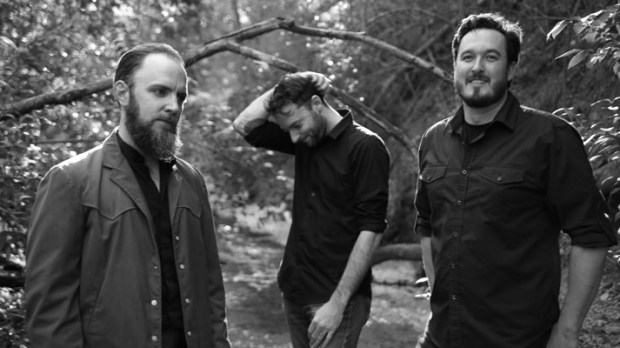Lenten Campaign 2025
This content is free of charge, as are all our articles.
Support us with a donation that is tax-deductible and enable us to continue to reach millions of readers.
“There will be no peace on earth for you or me…”
So begins the second album by Texas-based metal band The Angelus, There Will Be No Peace. The plaintive declaration, sung over little more than howling wind, hangs in the air like an inscription above an outer gate. But unlike Date’s inscription introducing us to the Inferno (“Abandon hope, all ye who enter here”), these words reintroduce us to the exile of the world – a place bereft of peace, but not of hope.
The band takes its name from the painting “The Angelus” by Jean-François Millet, which depicts two peasants breaking from their toil to recite the Catholic prayer after a church bell tolls. The feeling of “lonesome supplication” stuck with frontman Emil Rapstine years before he had a band around him, and got him thinking about the music of the Mass imprinted in his memory.
“I always really liked the drone of the organ with all of these voices singing behind it … it’s got this somber, melancholy sound to it,” he explained in a 2011 interview with The Volitionist. “At Easter … they wouldn’t play the organ during Lent, and they wouldn’t play any music until Easter Sunday … And so, when Easter came, I remember being an altar boy, and we were all handed bells. They all gave us bells, and then they would bust out with the organ when they would sing ‘Hallelujah,’ and we were instructed to play the bells as loud and as fast as we could, and I remember thinking, ‘This sounds awesome. This sounds amazing to me.’ There was something very transformative and … I can’t think of the word, but it was really grand sounding, and I really liked that.”
The band
as it evolved, and – without any intention of a religious message – naturally merged its Catholic sensibilities with a slow and solemn style of metal blended with post-rock and Appalachian folk. The result is a unique musical experience that the band struggles to define – False Metal, Hymnal Slowcore, Enchanted Rock, Gothspell – but one in which fans of The Bad Seeds or Wovenhand will feel right at home.After the chilling introduction and a thunderous instrumental, There Will Be No Peace sets out on a journey over moonlit terrain, one beset by darkness and beasts, thorns and stones, wind and sand. Rapstine’s voice is more Lord Huron than Nick Cave, but his lyrics likewise unveil the gloominess of a world broken by man’s brokenness – his wickedness, weakness, and transience. But almost as quickly as that vision threatens to overwhelm us, something happens. “Cast over, caught up in the wind, forgotten, forsaken,” Rapstine sings on “It Descends.” “Lost now, and left amongst the ruins, abandoned, yet awakened.” A kind of interior awakening – a spark of hope – rises into the outer dark.
In “As I Live and Breathe,” this hope comes under attack, but is not overcome:
As I rise, as I wake again
Feel the sun of a newborn day
I hold my heart, I hold my hope again
As it falls to pieces right before my eyes
Hallelujah, as I live and breathe
Hallelujah, as I live and breathe
The Catholic existentialist Gabriel Marcel saw man as a being thrown into a situation of finitude and despair, but nevertheless propelled, by hope, into movement. This is a fitting lens for There Will Be No Peace; the narrator is a kind of ontological itinerant, a pilgrim who moves through the bleakness of the world with his eyes fixed on the sun.
He eventually climbs by the “light of the Northern Star” to both the musical and symbolic pinnacle of the album, “The Other Side of the Mountain”:
The brooding music video, which caught the attention of NPR Music, shows a hooded figure delivering a mysterious light to a tormented man – a reflection, for Rapstine, of the themes of the album.
But this song is also a unique moment in the narrative because it’s a kind of arrival. But where? If the opening echo (“Dreamer arise, awake and go”) of Ephesians (“Awake, O sleeper, and arise”) hints toward an experience of the transcendent, the appearance of a mountain – a hugely important place of encounter with God in the Bible – has overwhelming religious significance. Whether this was a conscious decision or not, the mountain on this reading isn’t an ending or an escape from the world. In fact, Rapstine offers a kind of warning:
Brother, you’d better stand by me
Some fare fine but the other half die
On the other side of the mountain
And sister you’ll never, so stay away
It takes much more than the will to survive
On the other side of the mountain
The mountain is a new beginning, a holy place to hang “your little bundle of woe.” But the singer can’t rest; on the other side, the brokenness of the world is more magnified, our trials more abundant, our journey more urgent.
The album thus closes with the same refrain – “there will be no peace” – but without the slightest sense of despair. Instead, a thrashing finale announces a hard-won spiritual lesson: that for the pilgrim journeying through a foreign land, true peace is not a prize to be won but a promise to be kept.

